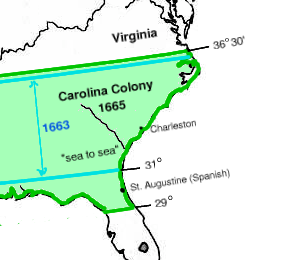Colonial period of South Carolina facts for kids
The colonial period of South Carolina describes when Europeans explored and settled the area that became South Carolina. This led to the creation of the Province of Carolina by English settlers in 1663. Later, in 1710, it was divided into the Province of South Carolina.
Large-scale European settlement began after 1651. People from the English colony of Virginia moved into the northern part. In the south, plantation owners from Barbados arrived. They set up large farms called plantations. These farms grew valuable crops like tobacco, cotton, rice, and indigo. They used the labor of enslaved people.
During the 1700s, Charleston became a very important port city. It was a key part of the triangular trade route. Colonists grew indigo, rice, and Sea Island cotton for export. These crops, grown with the help of enslaved people, made the colony very rich. South Carolina became one of the most successful of the Thirteen Colonies.
The colonial government fought against local Native American tribes and Spanish Florida. They also had to protect themselves from piracy. Many babies were born, and there was plenty of food. This helped the white population grow quickly, even with the danger of malaria. As more plantations started, many enslaved Africans were brought to South Carolina. By 1708, enslaved people made up most of the population. They were essential to the colony's growth.
The colony created its own laws and government. People started to believe strongly in republicanism. After 1765, many Patriots worried that British rules threatened their way of life. However, some people who had strong business and political ties to Britain supported the British king. These people were called Loyalists. When the American Revolutionary War began in 1775, South Carolina joined the Revolution. But the colony was deeply divided between Patriots and Loyalists. British forces invaded in 1780 and took control of much of the state. However, the Patriots eventually drove them out.
Contents
- Early European Exploration and Settlement
- How the Carolina Colony Began
- Conflicts and Challenges
- People of Colonial South Carolina
- Founding of Charles Town
- Monarchs of the Colonial Period
- From Proprietary to Royal Rule
- Settling the Frontier
- Cherokee Wars
- Growth of the Upcountry
- Religion in the Colony
- The Role of Enslaved Africans
- Hurricanes in Colonial South Carolina
Early European Exploration and Settlement
The first Europeans to reach the Carolinas were led by Pedro de Salazar. His group arrived between 1514 and 1516. They captured 500 Native Americans, but most died on the way back to Santo Domingo. In 1521, another trip led by Pedro de Quejo and Francisco Gordillo captured 60 Native Americans in Winyah Bay.
De Quejo returned in 1525 and explored the coast from Florida to Maryland. He captured more Native Americans to help as interpreters. His discoveries were put on a map in 1526. In 1526, Lucas Vázquez de Ayllón tried to start a colony in Winyah Bay. After a month, they moved to San Miguel de Gualdape in what is now Georgia.
In April 1540, the expedition of Hernando de Soto reached South Carolina. They then traveled to other modern-day states. A female chief, called Cofitachequi, welcomed them. She gave the Spanish soldiers pearls, food, and other goods. The expedition did not find much gold, only a few pieces from an earlier coastal trip.
The French briefly settled Charlesfort in 1562–63. The Spanish then settled it as Santa Elena from 1566–87.
How the Carolina Colony Began
In 1629, Charles I of England gave a large piece of land to his attorney general. Later, in 1663, Charles II of England gave this land to eight men called Lords Proprietors. This was a reward for their help in bringing him back to the throne in 1660.
Anthony Ashley Cooper became the main leader of the Lords Proprietors. John Locke worked with him as a chief planner. These two men helped create the "Grand Model for the Province of Carolina." This plan included important rules for the colony, called the Fundamental Constitutions of Carolina.
The new Carolina colony was meant to be an English stronghold. It would help protect lands that Spanish Florida also claimed. For a while, the Carolinas had one government based in Charleston. But in 1712, North Carolina got its own government. In 1719, the King bought the South Carolina colony from the Lords Proprietors. He then appointed Royal Governors. By 1729, most of the Lords Proprietors had sold their shares back to the King. This led to the official creation of the separate royal colonies of North Carolina and South Carolina.
Conflicts and Challenges
Throughout the Colonial Period, the Carolinas were involved in many wars. They fought with the Spanish and with various Native American tribes. Important tribes included the Yamasee, Apalachee, and Cherokee.
During the Yamasee War (1715–1717), South Carolina almost faced total destruction. Native American tribes attacked the colonists. An alliance of tribes formed to try and push the colonists out. This was partly because the colonists had been trading in Native American slaves for almost 50 years. This slave trade affected tribes all over the Southeast. It's estimated that Carolinians sold between 24,000 and 51,000 Native American slaves. These slaves were sent to markets as far away as Boston and Barbados.
The wealthy plantation owners used the money from these sales to buy enslaved Africans. So many Africans were brought in that they became the majority of the population in the colony from 1708 until the American Revolution. Living and working together on large plantations, they developed the Gullah culture and a creole language. They kept many West African traditions while adapting to their new home.
People of Colonial South Carolina
The coastal area, known as the Lowcountry, was home to rich plantation owners. Most of them were of English descent. The interior part of Carolina, called the upcountry, was settled later. In the 1700s, many Ulster Scots immigrants arrived through Pennsylvania and Virginia. There were also German Calvinists and French Huguenot refugees. Working-class English people who had finished their time as indentured servants also moved inland.
Towards the end of the Colonial Period, the upcountry people felt they were not fairly represented in politics. They believed the wealthy plantation owners treated them badly. Because of this, many upcountry residents became Loyalists when the Lowcountry planters started complaining about new taxes. This disagreement later played a role in the colony's support for the American Revolution.
Founding of Charles Town
A short-lived colony was set up near the mouth of the Cape Fear River in North Carolina. A ship was sent south to explore the Port Royal area in South Carolina. This was where the French had briefly built Charlesfort, and the Spanish had built Santa Elena. Captain Robert Sanford visited the friendly Edisto Indians. When the ship left to return to Cape Fear, Dr. Henry Woodward stayed behind. He wanted to learn about the land and the Native Americans.
In Bermuda, Colonel William Sayle, an 80-year-old colonist, was named governor of Carolina. On March 15, 1670, Sayle and many Bermudian families finally reached Port Royal. According to one passenger, the Native Americans were friendly. They showed them where to land and spoke some Spanish. Spain still believed Carolina was their land. Their main base, St. Augustine, was not far away.
The Edisto Indians were not happy about the English settling permanently. However, the chief of the Kiawah Indians, who lived further north, invited the English to settle near his people. He wanted protection from the Westo tribe, who were allies of Virginia and raided for slaves. The English agreed. In early April, they landed at Albemarle Point on the Ashley River. They founded Charles Town, named after their king.
On May 23, the ship Three Brothers arrived in Charles Town Bay. Eleven or twelve passengers were missing. They had gone for water and supplies at St. Catherines Island and met Native Americans allied with the Spanish. Out of hundreds of people who sailed from England or Barbados, only 148, including three enslaved Africans, made it to Charles Town Landing.
Monarchs of the Colonial Period
The table below shows the English monarchs who ruled during South Carolina's colonial period.
| Name Reign |
Portrait | Arms | Birth | Marriage(s) Issue |
Death | Claim | |
|---|---|---|---|---|---|---|---|
| Charles II 1663 – 6 February 1685 |
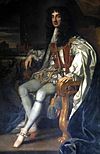 |
 |
29 May 1630 St James's Palace Son of Charles I and Henrietta Maria of France |
Catherine of Braganza Portsmouth 21 May 1662 No children |
6 February 1685 Whitehall Palace Aged 54 |
Son of Charles I | |
| James VII & II 6 February 1685 – 23 December 1688 (deposed) |
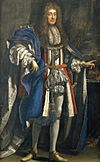 |
 |
14 October 1633 St James's Palace Son of Charles I and Henrietta Maria of France |
(1) Anne Hyde The Strand 3 September 1660 8 children (2) Mary of Modena Dover 21 November 1673 7 children |
16 September 1701 Château de Saint-Germain-en-Laye Aged 67 |
Son of Charles I | |
| Mary II 13 February 1689 – 28 December 1694 |
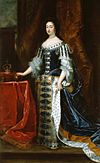 |
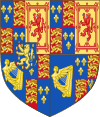 |
30 April 1662 St James's Palace Daughter of James II and Anne Hyde |
St James's Palace 4 November 1677 No children |
28 December 1694 Kensington Palace Aged 32 |
Daughter and son-in-law of James VII & II | |
| William III William of Orange 13 February 1689 – 8 March 1702 |
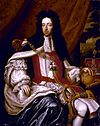 |
 |
4 November 1650 The Hague Son of William II, Prince of Orange and Mary, Princess Royal |
8 March 1702 Kensington Palace Aged 51 |
|||
| Anne 8 March 1702 – 1 May 1707 Queen of Great Britain and Ireland (from 1707) |
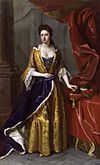 |
 |
6 February 1665 St James's Palace Daughter of James II and Anne Hyde |
George of Denmark St James's Palace 28 July 1683 17 pregnancies no surviving children |
1 August 1714 Kensington Palace Aged 49 |
Daughter of James II | |
| Anne 1 May 1707 – 1 August 1714 |
 |
 |
6 February 1665 St James's Palace Daughter of James II and VII and Anne Hyde |
George of Denmark St James's Palace 28 July 1683 17 pregnancies no surviving children |
1 August 1714 Kensington Palace Aged 49 |
Daughter of James II and VII | |
| George I George Louis 1 August 1714 – 11 June 1727 |
 |
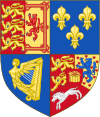 |
28 May 1660 Leineschloss Son of Ernest Augustus, Elector of Brunswick-Lüneburg and Sophia of Hanover |
Sophia Dorothea of Brunswick-Lüneburg-Celle 21 November 1682 2 children |
11 June 1727 Osnabrück Aged 67 |
Great-grandson of James VI and I | |
| George II George Augustus 11 June 1727 – 25 October 1760 |
 |
 |
30 October 1683 Herrenhausen Son of George I and Sophia Dorothea of Brunswick-Lüneburg-Celle |
Caroline of Brandenburg-Ansbach 22 August 1705 8 children |
25 October 1760 Kensington Palace Aged 76 |
Son of George I | |
| George III George William Frederick 25 October 1760 – July 4, 1776 Monarchy Abolished |
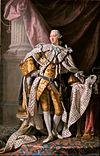 |
 |
4 June 1738 Norfolk House Son of Frederick, Prince of Wales and Princess Augusta of Saxe-Gotha |
Charlotte of Mecklenburg-Strelitz St James's Palace 8 September 1761 15 children |
29 January 1820 Windsor Castle Aged 81 |
Grandson of George II |
From Proprietary to Royal Rule
The Province of Carolina was founded in 1670. Many of the first settlers were planters from the English sugar island of Barbados. They brought many enslaved Africans from Barbados to start new plantations.
To get enough workers for farming, colonists also enslaved Native Americans for a time. The Carolinians changed the Native American slave trade. They treated these enslaved people as goods to be sold, mostly to the West Indies. Historians estimate that between 1670 and 1715, between 24,000 and 51,000 captive Native Americans were sold from South Carolina. This was more than the number of Africans brought to the future United States during the same time.
Rule by the Lords Proprietors was not popular in South Carolina. Many wealthy immigrants wanted to control the government themselves. Also, many Anglicans (members of the Church of England) did not like that the Proprietors allowed freedom of religion for other Protestant groups.
In November 1719, Carolina elected James Moore as governor. They asked the King to make Carolina a royal province with a royal governor. They wanted direct help and protection from the English government. The King agreed because he was interested in Carolina's exports. He also thought the Lords Proprietors were not protecting the colony well enough. Robert Johnson, the last proprietary governor, became the first royal governor.
Meanwhile, the colony of Carolina slowly split into two. For the first 50 years, most settlements were around Charleston. The northern part of the colony did not have a deep-water port. North Carolina's first settlements were made by people from Virginia and were closely connected to Virginia. In 1712, the northern half of Carolina got its own governor and was called "North Carolina." North Carolina remained under proprietary rule until 1729.
Because South Carolina was more populated and important for trade, most Europeans thought of it when they said "Carolina." By the time of the American Revolution, this colony was known as "South Carolina."
Settling the Frontier
Governor Robert Johnson wanted people to settle the western frontier. This would make Charleston's shipping more profitable. It would also create a protective area against attacks. The Carolinians set up a fund to attract European Protestants. Each family received free land based on how many people they brought, including indentured servants and enslaved people.
Every 100 families settling together would become a parish. They would get two representatives in the state assembly. Within ten years, eight towns formed along rivers. People in Charleston saw these new towns as their first line of defense. They would protect against Native American attacks and serve as military reserves against the threat of slave uprisings. These towns were created by Huguenots, German Calvinists, Scots, Ulster-Scots Presbyterians, working-class English laborers, and Welsh farmers. Examples include Orangeburg and Saxe-Gotha (later Cayce).
Between 1729 and 1775, 29 new towns were founded in South Carolina. Many settled in what are now Marion, Darlington, and Marlboro Counties along the Pee Dee River. By the 1750s, the Piedmont region attracted many frontier families from the north. They used the Great Wagon Road. Many Welsh farmers moved to the region between 1737 and 1777. They were mostly religious migrants. They left Wales because they were Calvinist Baptists and faced pressure to join the Anglican faith.
About 80% of all European settlers in colonial South Carolina were of English origin. However, many came to Carolina from Barbados rather than directly from England.
Differences in religion and background grew between the mostly small farmers in the Upcountry and the slave-owning planters of the Low Country. This led to distrust and hostility. The Low Country planters traditionally had wealth, education, and political power. By the time of the Revolution, the Upcountry had almost half of South Carolina's white population, about 30,000 settlers. Most of them were Dissenting Protestants. After the Revolution, the state government removed the Anglican Church as the official church.
The main source of wealth in the late colonial period was the export of rice, deerskins, and later, indigo. Sea Island cotton, grown on large coastal plantations, was also very profitable.
Cherokee Wars
Governor Francis Nicholson tried to make peace with the Cherokee with gifts. However, the Cherokee were still unhappy. Sir Alexander Cuming negotiated with them to open some land for settlement in 1730. Governor James Glen helped make peace between the Creek people and Cherokee, who were old enemies. The Cherokee rewarded him by giving South Carolina land near their town of Keowee. As part of this peace, the Creek agreed in 1743 to let South Carolina build a trade fort near Okfuskee, called Fort Okfuskee.
In 1753, the Carolinians built Fort Prince George as a British outpost and trading center near the Keowee River. Two years later, Old Hop, an important Cherokee chief, signed a treaty with Glen. Old Hop gave the Carolinians the 96th District, a large region of land.
From 1755 to 1758, Cherokee warriors helped the British fight along the Virginia and Pennsylvania borders. On their way home, Virginia frontiersmen killed some of them. In 1759, the Cherokee got revenge and began attacking white settlers in the southern Upcountry. South Carolina's Governor William Henry Lyttelton gathered an army of 1,100 men. He marched on the Lower Towns, and they quickly agreed to peace. As part of the peace, two dozen Cherokee chiefs were held as hostages in Fort Prince George.
Lyttelton returned to Charleston, but the Cherokee continued raiding the frontier. In February 1760, the Cherokee attacked Fort Prince George to rescue the hostages. The fort's commander was killed in the battle. His replacement quickly ordered the hostages to be executed, then fought off the Cherokee attack.
Unable to stop the attacks, Governor Lyttelton asked Jeffrey Amherst for help. Amherst sent Archibald Montgomery with an army of 1,200 British soldiers. Montgomery's army burned some of the Cherokees' empty Lower Towns. When he tried to enter the Cherokee Middle Towns, he was ambushed and defeated. He was forced to return to Charleston.
In 1761, the British made a third attempt to defeat the Cherokee. General Grant led an army of 2,600 men, including Catawba scouts. The Cherokee fought at Etchoe Pass but could not stop Grant's army. The British burned the Cherokee Middle Towns and their crop fields.
In September 1761, several Cherokee chiefs, led by Attakullakulla, asked for peace. The peace treaty was signed in Charleston that December. It included giving up lands along the South Carolina frontier.
Growth of the Upcountry
After the Cherokee were defeated and gave up land, new settlers from Ulster poured into the Upcountry. They came through the Waxhaws in what is now Lancaster County. Lawlessness followed, with robbery, arson, and looting becoming common. Upcountry residents formed a group called "Regulators." These were vigilantes who took the law into their own hands to control criminals.
The Upcountry now had 50% of the state's white population. However, it only had three elected assemblymen in the Commons House of Assembly. The Upcountry sent representatives like Patrick Calhoun to the Charleston state legislature. They asked for more representation, courts, roads, and support for churches and schools. Soon, Calhoun and Moses Kirkland became Upcountry representatives in the legislature.
By 1770, the colony had 124,000 people. It is not known exactly how many were European Americans, African Americans, or Native Americans. An estimated 80,000 to 100,000 enslaved people gained freedom during the Revolutionary War. Some escaped on their own, and others left with the British.
Lord William Campbell was the last British governor of the Province of South Carolina.
Religion in the Colony
Many churches were built in Charleston and then spread to rural areas. From Charleston's founding, the colony welcomed different religious groups, including Jews and Quakers. However, Catholics were not allowed to practice their faith until after the American Revolution.
Baptists and Methodists grew rapidly in the late 1700s. This was due to the First Great Awakening and its revivals. Their missionaries attracted many enslaved people with their welcoming congregations. They also recognized Black people as preachers. The Scots-Irish in the Backcountry were Presbyterians. The wealthy planters in the Low Country were usually English Anglicans. The different churches recognized and supported each other. This helped the colony become a diverse and tolerant society. Despite official religious tolerance, there were some tensions between Anglican and 'Dissenter' groups in the late 1600s and early 1700s.
The very successful preaching tour of evangelist George Whitefield in 1740 started a religious revival. This was called the First Great Awakening. It energized Protestant groups. They gained many new members among white farmers. Women were especially active in the small Methodist and Baptist churches that appeared everywhere. These groups worked hard to convert enslaved people to Christianity. They were especially successful among Black women. Black women had often been religious leaders in Africa and continued this role in America. Enslaved women had wide-ranging spiritual leadership among Africans in America. This included healing, church discipline, and leading revivals.
The Role of Enslaved Africans
Many wealthy planters came from Barbados and other Caribbean islands. They brought experienced enslaved Africans with them. The planters copied parts of the Caribbean economies. They developed plantations to grow crops for export, such as Sea Island cotton, indigo, and especially rice.
The enslaved people came from many different cultures in West Africa. They had developed an immunity to malaria, which helped them survive in the Low Country of South Carolina, where malaria was common. Historian Peter Wood notes that "Negro slaves played a significant and often determinative part in the evolution of the colony." They were essential to the growth of rice farming. They were also important in cutting timber, making barrels, and producing naval supplies. They also worked in the fur trade, as boatmen, fishermen, and cattle herders.
By 1708, the growth of plantation agriculture required more enslaved people from Africa. They made up most of the colony's population, a situation that continued after the colonial era. On the large rice and cotton plantations, enslaved people lived and worked in large groups with few white overseers. They gradually developed what is known as the Gullah culture. This culture kept many African customs and practices while adapting to the new environment. They also developed a creole language based on West African languages and English.
Colonists tried to control the large number of enslaved people. They even set rules about what enslaved people could wear to maintain class differences. Relations between colonists and enslaved people were a constant negotiation. Tensions increased as enslaved people sought more freedom. In 1739, a group of enslaved people rebelled in the Stono rebellion. Some leaders were from the Catholic kingdom of Kongo and seemed to be experienced warriors. They used ritual practices and military tactics they had learned in Kongo. The site of the Stono Rebellion was recognized as a National Historic Landmark in 1974. This honored the enslaved people's fight for freedom.
The strict Negro Act of 1740 was passed in South Carolina. This happened during Governor William Bull's time in office, in response to the Stono Rebellion in 1739. The act made it illegal for enslaved Africans to travel freely, gather in groups, grow food, earn money, or learn to write. Owners were also allowed to kill rebellious slaves if needed. This Act remained in effect until 1865.
Hurricanes in Colonial South Carolina
South Carolina was hit by four major hurricanes during the colonial period. Colonists were always aware of the danger these storms posed. The storms even affected warfare.
The 1752 hurricane caused huge damage to homes, businesses, ships, and plantation buildings. About 95 people died. Charleston, the capital, was the fifth-largest city in British North America at the time. The storm was small but powerful. The city and nearby areas were saved from even worse destruction because the wind changed direction a few hours before high tide. The destruction led to political problems. There was arguing between government leaders over money to rebuild the colony's defenses. The disruption also caused a serious financial crisis.
|


